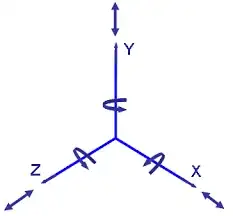We all have learnt that a single atom posses 3 translational degree of freedom and no other. But it happen to be a sphere too. Is it correct to say that a sphere has 3 rotational degree of freedom? Like in this figure:

6 Answers
Degrees of freedom depend on symmetry: if you apply an operation to the object, does it produce a discernable difference?
Clearly a movable object has three translation degrees of freedom.
A geometric sphere is symmetric under rotation: if there is no markings on the surface rotations do not produce any change. So there are no rotational degrees of freedom. This is why monoatomic molecules have zero rotational degrees of freedom in statistical mechanics. This can empirically be tested by measuring e.g. heat capacities at low temperature: had there been extra degrees of freedom they would have been different.
However, a physical sphere can be rotating around an axis. The angular momentum has a direction and angular velocity magnitude. If you rotate that sphere there will be a discernable difference since it affects the angular momentum (unless it is zero).
Why doesn't this give monoatomic gases more degrees of freedom? This is because getting to the first excited rotation energy levels require more energy than we usually experience in chemistry. So the answer to some degree depends on what kind of environment we consider, and whether we are in classical or quantum physics.
- 34,657
One of the assumptions of the Kinetic theory of Gases says
The gas consists of very small particles known as molecules. This smallness of their size is such that the total volume of the individual gas molecules added up is negligible compared to the volume of the smallest open ball containing all the molecules. This is equivalent to stating that the average distance separating the gas particles is large compared to their size.
So Particle is considered as point-like and thus we can neglect any rotational or vibrational motion of the molecules and consider the only translational motion of molecules (so these results are strictly applicable only to a monatomic gas).
Any rigid body has $6$ degrees of freedom. So Yes! a Sphere has $6$ degrees of freedom.
- 12,211
Well yes, in analogy to the atom, a sphere has three translational degrees of freedom. However, unlike a point particle, their sphere has dimensions and hence it is meaningful to talk about rotations of this object. Since it can rotate along the three axes which it can move in, it has three additional rotational degrees of freedom to its translational one.
- 8,309
The rotation of any quantum object is quantised. The angular momentum can only increase in discrete steps and as a result we get rotational energy levels with energies:
$$ E_J = J(J+1) \frac{\hbar^2}{2I} $$
where $I$ is the moment of inertia and $J$ is the rotational quantum number $J = 0,1,2,3,$ and so on.
Notice that the energy is inversely proportional to the moment of inertia, $I$. The problem with an atom is that although it is indeed roughly a sphere $99.9\%$ of the mass is concentrated in the nucleus and that is only $10^{-15}$m across. The result is that the moment of inertia of an atom is tiny, and as a result the rotational energy of even the first rotational state is too large to be seen under normal circumstances.
Rotational excitations of nuclei can be observed in colliders, but the energies involved are in the mega electron volt range. By contrast the rotational energies of simple molecules are more like one hundredth of an electron volt or $10^8$ times smaller.
This is also why linear molecules only have two rotational degrees of freedom.
- 367,598
- All three dimensional objects, if not constrained, have three rotational and three transnational degrees of freedom. (maybe the reason for the term "six degrees of freedom").
- 354
Answers by John Rennie and Anders Sandberg have correctly stated the situation for atoms. But this involves the fact that atoms are not always exactly spheres because they can adopt states in which their intrinsic angular momentum is not zero (in more everyday language: they can rotate).
It is interesting also to consider the case of a hypothetical exactly spherical object, treated by quantum theory. This occurs for spin-zero particles, for example, when their wavefunction is spherically symmetric. In such a case, if you apply a rotation to the wavefunction, then strictly nothing changes. A particle which has somehow been restricted to states of this kind does not have any degree of freedom associated with rotation.
- 65,285